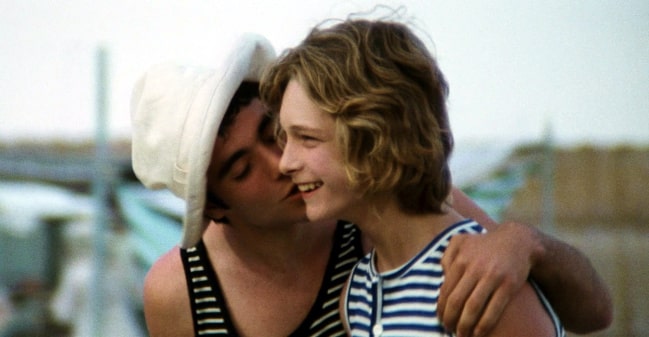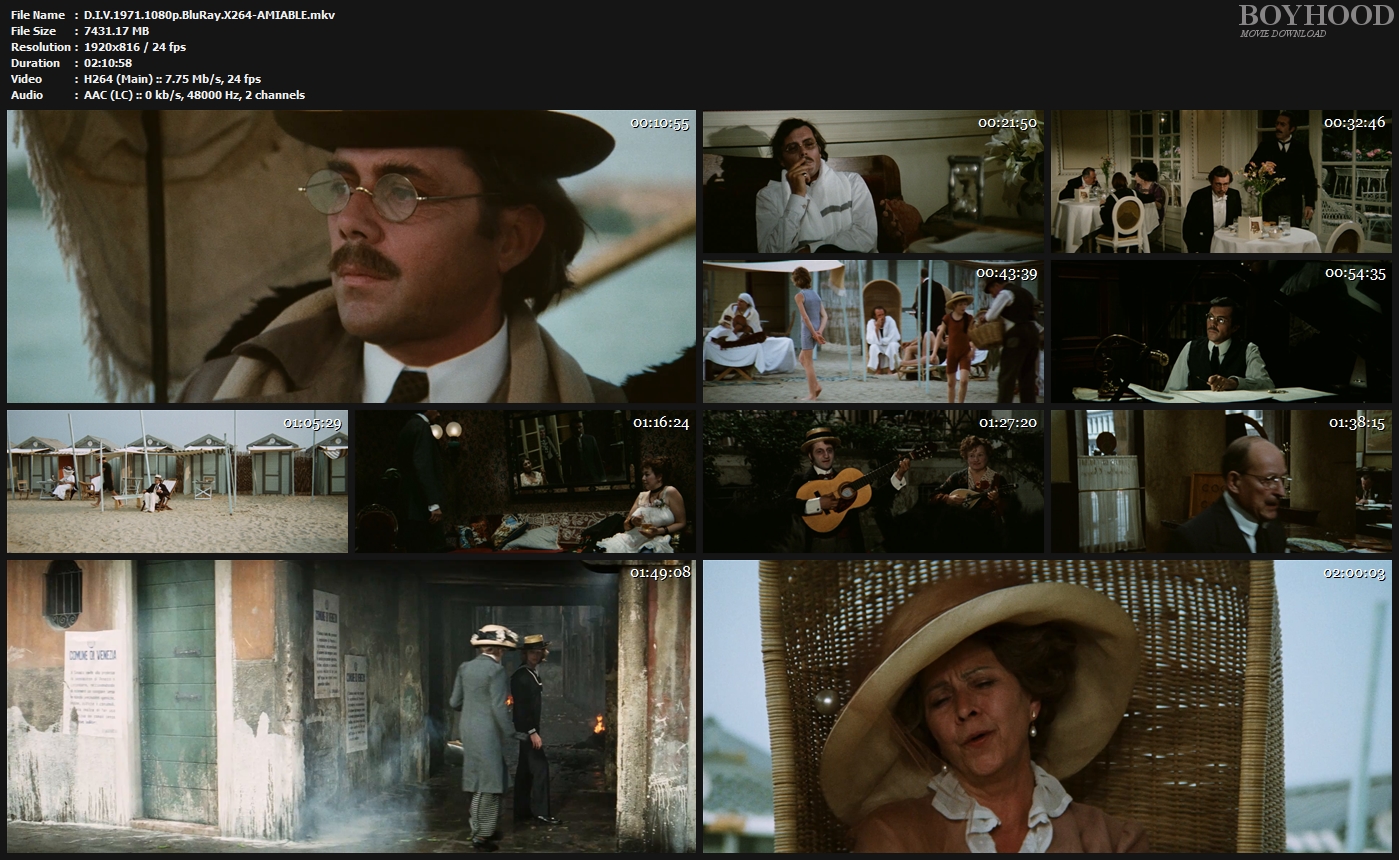
Death in Venice 1971
Death in Venice 1971
Morte a Venezia (original title)
2h 10min | Drama | 1 March 1971 (UK)
Storyline:
In this adaptation of the Thomas Mann novel, avant-garde composer Gustave Aschenbach (loosely based on Gustav Mahler) travels to a Venetian seaside resort in search of repose after a period of artistic and personal stress. But he finds no peace there, for he soon develops a troubling attraction to an adolescent boy, Tadzio, on vacation with his family. The boy embodies an ideal of beauty that Aschenbach has long sought and he becomes infatuated. However, the onset of a deadly pestilence threatens them both physically and represents the corruption that compromises and threatens all ideals.
User review:
I’m not sure where to start with this. In short, it was a disappointing movie. Having taught the novella, I was aware that it would be a hard story to turn into a movie. The movie has a couple of interesting lines (mainly between Alfred and Aschenbach) but it doesn’t represent the debate on art that basically shapes the novella.
For one, I was expecting an older Aschenbach and a younger Tadzio. In the book, Tadzio is fourteen, but he is described as pure, ideal, innocent, whereas in the movie he reeks of sexuality and is a tease. He is an accomplice to Aschenbach, he always looks back at him, almost provokingly. In the book, it is Aschenbach who steals glances at the boy. As for Aschenbach, I imagined something closer to the professor-turned-clown in The Blue Angel (based on a story by Thomas Mann’s brother Heinrich) than this forty-year old with hardly any gray hair. In all fairness, I do think that Dirk Bogarde did a good job, but either someone else should have done that, or he should have made to look older at the beginning.
I know that the discovery of homosexuality is important to the story, but the movie minimizes the talk about art and the duality between the Apollonian and Dyonisian inspirations and focuses instead on Aschenbach’s obsession of Tadzio and does not justify it. I liked the fact that Mahler’s music was used, because ultimately he did inspire Mann to write his story. I’m not sure turning Aschenbach into a musician was a particularly good move. Or the creation of Alfred who I don’t remember in the book.
And one thing that really got to me was the sound and how it did not match the actors’ lips. I was wondering if it was dubbed because I expected it to be in Italian. But then I remembered that each Italian movie I have watched has this problem. It just bothers me because these directors (Fellini is the other person I’m thinking of) are supposed to epitomize perfection in Italian cinema, and here are their characters laughing without sound, then you hear a noise that doesn’t correspond to their faces (I’m thinking of the scenes when Aschenbach almost collapses and starts laughing. This scene could/should have been the strongest, but it was annoying instead).
Director: Luchino Visconti
Writers: Thomas Mann (novel), Luchino Visconti (screenplay),
Stars: Dirk Bogarde, Romolo Valli, Mark Burns
Country: Italy | France | USA
Language: English | Italian | Polish | French | Russian | German
Also Known As: Death in Venice
Filming Locations: Cinecitta Studios, Cinecitta, Rome, Lazio, Italy
http://www.imdb.com/title/tt0067445/
Format : Matroska
Format version : Version 1
File size : 7.26 GiB
Duration : 2 h 10 min
Overall bit rate : 7 932 kb/s


































As an aside, I have once seen it stated confidently that Mahler had an erotic or romantic interest in adolescent boys. Suffice it to say, there is no evidence for this that I am aware of. No doubt the rumor started after someone watched “Death in Venice”, learned that Aschenbach was vaguely based on Mahler, and jumped to conclusions!
As for the film, I know what you mean. It seems to pointlessly ramble on and on. I once saw a video of scenes from the film accompanied by music. It was about ten minutes long, and I found it far more mesmerizing than the film itself. Still, the film is very definitely watchable, even if only for one of its lead actors… 😉
The file size is wrong. It’s on nitroflare as 840.5 MB
Better copy added!
missing .part3
Admin, are you going to replace the missing links pls?
Admin, are you going to replace the missing links pls?
Sure
sorry for the duplicating request.
I dunno how that happened.
Hi Administrator, I wonder if part 3 could be uploaded so as to allow the movie to be watched in full? We are all looking forward to watching this remarkable film in full HD again.
Thanks for your help!
Adding my voice with request to post Part 3 if at all possible. Many thanks
Missin pard 2 and part 3
In the folder is only oart1?
Smaller rip added
My review of DEATH IN VENICE, directed by Luchino Visconti in Panavision and Technicolor (Warner Bros. 1970).
Whilst visiting Venice in 1911 author Thomas Mann’s eye was drawn to a young sailor-suited 11 years old Polish boy of almost supernatural beauty who was staying with his family at the same hotel as Mann. His name was Wladyslaw Moes (1900 – 1986) and Mann became infatuated with him, his unrequited feelings for him inspiring him to write his best selling novel “Death in Venice”.
In 1970, director Luchino Visconti brought the novel to the screen, with the novelist of the book turned into a composer played by Dirk Bogarde and, aged up from 11 to 14 to make the character more acceptable to modern audiences, the stunning Bjorn Andresen as the Tadzio / Wladyslaw of Mann’s novel. Bogarde’s character was based on the composer Gustave Mahler (1860 – 1911), whose beautiful and haunting symphonies numbers 3; 5 and 7 were used as a soundtrack score for the film. Regarding this, the story goes that when the film was played in a private screening to Warner Brothers executives in London in 1971, there was a long silence after the film ended until one of the executives said: “That’s one hell of a score…who wrote it?” “Gustave Mahler”, Visconti told him. “Fine”, said the executive, “we’ll sign him!” “I think you’ll find that very difficult”, Visconti told him. “Why?”, asked the executive. “Because he died over sixty years ago”, said Visconti.
Aged and sick Gustav von Aschenbach – a novelist in the Thomas Mann novel, a composer in the film – travels to Venice to convalesce, where he becomes obsessed with the stunning beauty of an adolescent boy named Tadzio whom he sees while the two are staying at the same hotel, the boy with his family. An epidemic of Asiatic cholera has just broken out and von Aschenbach plans to leave Venice, but changes his mind because he can’t bear to be away from Tadzio, even though he has never even had the opportunity of talking to the boy or getting to know him. As his holiday continues, von Aschenbach’s entire existence begins to revolve around following this young boy, both a symbol of his faded youth and of sexual attractions and desires in his life that von Aschenbach never made a reality.
There is a memorable scene in a lift at the hotel. Von Aschenbach is in the lift when a group of boys enter it, one of them Tadzio. The look of longing and yearning on the man’s face and the look of love in his eyes when he sees Tadzio, only a few feet away from him…so near and yet so far away…is something that anyone who has ever been in a similar situation could identify with only too well. The other boys, noticing the man’s only too obvious interest in their friend, tease Tadzio quietly about it. When the lift stops at Tadzio’s floor, the boy walks past von Aschenbach and out of the lift, then turns to face von Aschenbach, who is still in the lift and gives him a knowing look, before turning and walking away. This disturbs von Aschenbach greatly and, when he gets to his room, he sits on a chair and buries his face in his hands and weeps for the boy.
In another scene, von Aschenbach is taking a stroll down to the beach, following Tadzio, who is dressed in a skin tight swimsuit that leaves little to the imagination regarding the crotch area. Suddenly, Tadzio, aware that von Aschenbach is following him, turns around and grabs the pole of the awning of the covered walkway and swings around it, in doing so, facing von Aschenbach, before moving on to the next pole and doing the same again, as if teasing the poor man.
Tadzio seems well aware of von Aschenbach’s obvious interest in him and keeps giving the old man the kind of look guaranteed to set his desires to fever pitch…almost as if he was enjoying teasing the old man with a look that says: “Would you like to have me and play with me?” A really superb film about an old man’s hopeless unrequited love for a beautiful teenage boy.
If a man is attracted to a beautiful teenage boy, well, he’s attracted to a beautiful teenage boy and there’s nothing he can do about it. He can’t help his feelings, any more than a man attracted to a woman can help his feelings. His feelings are who he is. They are his identity. I think that if this story had been set in the early 1970’s instead of in 1911, the central character may have been able to identify with some of the lyrics in an old Jimmy Helms hit from 1973: “Did you ever sit, waiting; hoping; longing for something that’s never gonna be?” I think those words pretty well sum up just what this picture is all about.
Bogarde portrays a man who suddenly comes up against something he doesn’t know how to handle…his obvious attraction to and love for this beautiful young boy. In fact, he is so taken aback by this that he doesn’t know what to do about it. He knows that if he comes right out and confronts the boy and tells him how he feels about him, the boy may reject him and that would hurt even more than not doing anything at all. So he talks to the boy when the boy isn’t there, or when they’ve just passed each other and the boy has smiled at him. “Don’t smile like that at anybody ever again, Tadzio…never again. I love you.”
Critics were more than a bit divided in their assessment of the film. I remember one who wrote: “For over two hours, von Ashenbach (Dirk Bogarde), who has the hots for the 14 years old Tadzio (Bjorn Andresen), follows him around Venice looking longingly at him and nothing happens. I wanted to rise from my seat and shout ‘For God’s sake, grab the boy and kiss him!”